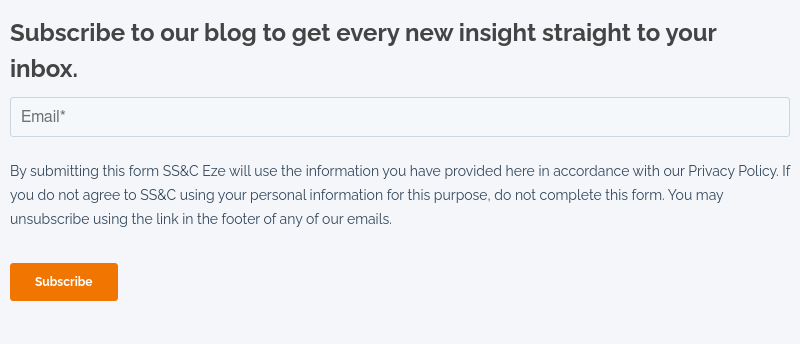RealTick was the first product I worked with when I joined what was then Eze Software Group in December 2013. The product had a long and proven track record as a trusted execution management system for the electronic trading of equities, futures, and options.
It had even flirted with supporting bonds at various points in its 30-year history. At one point, RealTick had connectivity to NYSE Arca Bonds, and at another, it had a dedicated RFQ ticket for trading convertible bonds with Lehman Brothers!
If you’re the nostalgic type, I’m sure one of our tenured developers will enable it for you for old times’ sake. The ticket is still functional, but there might not be anyone on the other side.
Today, the well-documented march towards electronic bond trading and the increasingly multi-asset nature of traders due to desk consolidation are just two of the forces driving the demand for what the market is calling a fixed-income EMS.

When One Platform Isn’t Enough
Let’s say I’m only trading US corporate bonds. I find that just one platform provides everything I need to manage my orders, find liquidity, assist with price discovery, and ultimately execute trades. That platform would be my fixed-income EMS, wouldn’t it?
Increasingly, one platform does not suffice. Either:
- because the range of bonds you trade requires that you have access to specialized products tailored to different segments
- or because liquidity in one segment is getting more fragmented as competition intensifies and new entrants gain a foothold.
Liquidity is annoyingly fickle.
A Consolidated Fixed-Income EMS Versus a Multi-Asset EMS
When it comes to using software to aggregate execution platforms, there are, broadly speaking, two camps.
1. The first, and probably loudest, are those that express a desire to consolidate all trading functionality of the various execution platforms into one platform.
They talk about buy-sides becoming more like dealers, responding to RFQs, distributing their own pricing, and using an EMS as a tool to do that.
While the idea of a fixed-income EMS is certainly exciting, is it something that the mass market—not just tier 1s—actually values, considering the inevitable expense of such a tool?
2. The other group includes the community that enjoys using an EMS for equities, futures, and options and simply wants to add fixed income to the same blotter for convenience.
Their goal is to spend less time—not no time—on specialized execution platforms, reserving their valuable time for situations where those platforms’ advanced tools are necessary and worth the swivel.
It is this second group that I spend my time thinking about. Given the development expense of building ever-tighter integrations with execution platforms, how far across the spectrum should we go before the marginal gains are eclipsed by the marginal cost?
Even the Best Traders Only Have Two Eyes
The problem is not that the increased prevalence of execution platforms has led to a data explosion; it’s that each platform presents the data it has within the confines of its own applications.
How can we consolidate the myriad of quotes, axes, runs, dealer streams, inventory, trade history, evaluated price feeds, competing quote history, and more and turn that data into information?
Supporting the decision of which platform, protocol, and liquidity pool to use ultimately is valuable to all users regardless of the method aiding in that decision. When it comes to SS&C’s role in this process, rather than compete with venues directly, I believe the market wants us to help make sense of the chaos.
The liquidity platforms are opening up and distributing their data as feeds to their clients’ upstream systems. EMSs, more so than traditional OMSs, are built to consume and aggregate vast amounts of streaming data, so commingling those feeds with other sources should come somewhat naturally.
Reintroducing: Fixed Income Trading in RealTick
For these reasons and more, in our latest release, we are reintroducing fixed income to RealTick. There are over 5 million corporate, government, municipal, and securitized bonds to choose from, and we have established connectivity to Bloomberg, Tradeweb, and MarketAxess for trading.
Fixed-income capabilities available in RealTick:
- Book trades manually, receive unsolicited fills, consume axes and co-mingle them with other market data sources.
- Capture and normalize competing quotes (in a future release, this will help build a transaction history to support dealer selection).
- Manage bond trading from an existing blotter.
The focus is on convenience and eliminating what we call “pivot pain”— multi-asset traders switching back and forth between the EMS and OMS.
What is a Fixed-Income EMS?
Now, whether or not the product I’ve described is worthy of the title “fixed-income EMS” depends on your definition.
Suppose your definition of a fixed-income EMS requires that it either challenges incumbent fixed income trading venues – like Bloomberg, Tradeweb, and MarketAxess – with an alternative liquidity pool or integrates with them to render them obsolete as software products. If that’s the case, then RealTick is not a fixed-income EMS.
Most traders I’ve spoken to understand that the liquidity platforms are necessary, provide valuable tools, and aren’t going anywhere.
Sure, traders want their trading workflows to be as streamlined as possible. But I think they would prioritize a multi-asset blotter with connectivity if that tool also helped them to decide which platform to target, which dealers to approach, and which trading protocol to use.
That would certainly be a useful piece of software, but for some camps in the market, I suppose it just wouldn’t be a fixed-income EMS.


